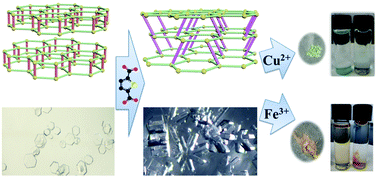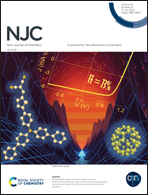A three-dimensional metal–organic framework with high performance of dual cation sensing synthesized via single-crystal transformation†
Abstract
A layer-pillared three-dimensional (3D) metal–organic framework (MOF) BUT-26 was synthesized from a two-dimensional (2D) MOF BUT-25 through single-crystal to single-crystal (SC-SC) transformation. Two honeycomb-shaped layers were linked by formate ions forming a bilayer structure of BUT-25. The formate pillar was then exchanged by the subsequently added ligand thiophene-2,5-dicarboxylic acid (H2TDC), which successfully stitched the 2D layers of BUT-25 into 3D BUT-26 without disturbing the original honeycomb-shaped layers. Interestingly, BUT-26 with free nitrogen and oxygen sites proved to be a highly sensitive MOF-based sensor with a limit of detection (LOD) of 0.12 μM and 0.1 μM for Cu2+ and Fe3+ ions, respectively. These LOD results are much lower than the minimum values of these ions in drinking water specified by the US-EPA. Sensitive detection accompanied by a visible color change in the solution and solid phase confirms that BUT-26 can be used for colorimetric sensing of both ions.



 Please wait while we load your content...
Please wait while we load your content...